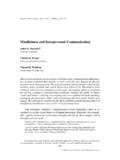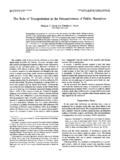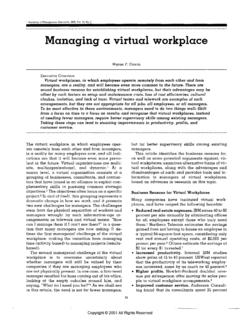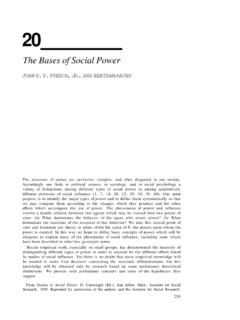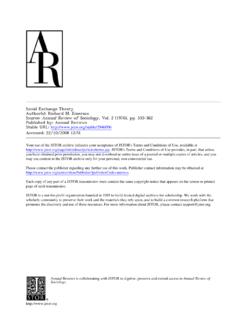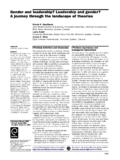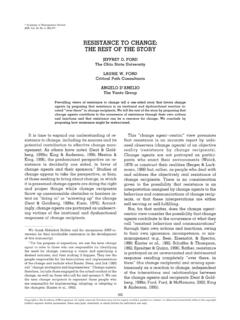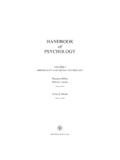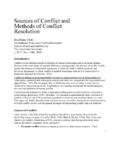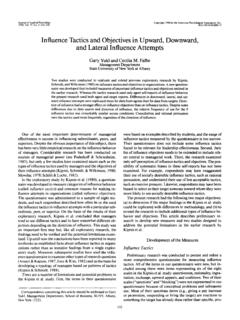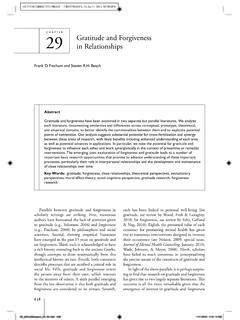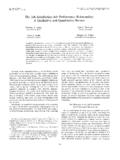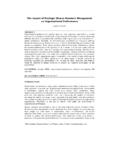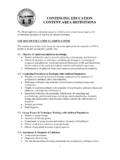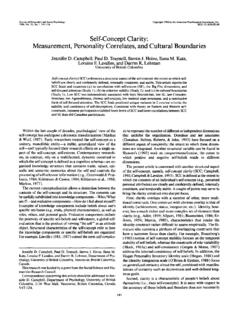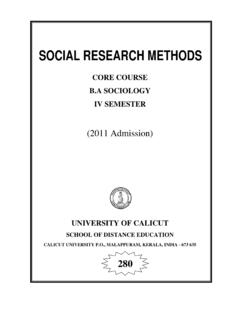Transcription of Attitude Change: Persuasion and Social Influence
1 Annu. Rev. Psychol. 2000. 51:539 570 Copyrightq2000 by Annual Reviews. All rights reserved0084 6570/00/0201 0539$ : Persuasion and SocialInfluenceWendy WoodDepartment of Psychology, Texas A&M University, College Station, Texas 77843;e-mail: Wordsinfluence, motives, fear appeals, Social identityAbstractThis chapter reviews empirical and theoretical developments inresearch on Social Influence and message-based Persuasion . The review emphasizesresearch published during the period from 1996 1998. Across these literatures, threecentral motives have been identified that generate Attitude change and involve concerns with the self, with others and the rewards/punishments theycan provide, and with a valid understanding of reality.
2 The motives have implicationsfor information processing and for Attitude change in public and private in Persuasion also have been investigated in research on Attitude functionsand cognitive dissonance theory. In addition, the chapter reviews the relatively uniqueaspects of each literature: In Persuasion , it considers the cognitive and affective mech-anisms underlying Attitude change, especially dual-mode processing models, recipi-ents affective reactions, and biased processing. In Social Influence , the chapterconsiders how attitudes are embedded in Social relations , including Social identitytheory and majority/minority group for Agreeing with Versus Private 542 Motives in Persuasion 544 Cognitive Dissonance 546 Multiple of Multiple 548 Influence and Multiple 549 Dual-Mode Processing Models of Response Mediation of Attitude 552 Dual-Mode Processing Models and Social 553 Motivated Processing and Bias 554 Affect and of 555 Fear 556 Group and Rev.
3 Psychol. :539-570. Downloaded from UNIVERSITY OF ILLINOIS - CHICAGO on 08/27/09. For personal use Consensus and Validity of 558 Multiple Motives Instigated by 559 Opinion Minority and Majority chapter reviews the research on Attitude change from what traditionally havebeen two separate areas of inquiry, the study of message-based Persuasion andthe study of Social Influence . In the Persuasion paradigm, Influence appeals typ-ically include detailed argumentation that is presented to individual recipients ina context with only minimal Social interaction.
4 Social Influence appeals, in con-trast, usually consist solely of information about the source s position, but theseare delivered in more complex Social settings that may include interaction amongparticipants. Because of the marked continuities in the theoretical analyses andin the empirical findings that have emerged across these research areas in the pastfew years, this review draws from both literatures. It emphasizes in particularresearch published during 1996 to 1998, since the prior review of Petty et al(1997).Giving Social Influence research a significant role in the current review requiresthat limited attention be given to some other research areas that have been featuredprominently in the past.
5 Work on Attitude structure and on Attitude -behavior rela-tions has continued to flourish, and Eagly & Chaiken (1998) provide an excellentreview elsewhere. Also noteworthy, despite some overlap with the current review,are Petty & Wegener (1998a), Cialdini & Trost (1998), and Chaiken et al (1996b).Another research area beyond the scope of this chapter is the extensive work onintergroup attitudes and stereotypes (Brewer & Brown 1998, Fiske 1998).MOTIVES FOR AGREEING WITH OTHERSA hallmark of Social Influence research is the delineation of the multiple motivesthat spur agreement or disagreement with others.
6 For over 40 years, the centralorganizing perspective in this area has been a dual-motive scheme that differen-tiates between informational Influence , which involves accepting informationobtained from others as evidence about reality, and normative Influence , whichinvolves conformity with the positive expectations of another, who could be another person, a group, or one s self (Deutsch & Gerard 1955:629).Yet contemporary theories of motives for Attitude change and resistance appearto be converging instead on a tripartite distinction ( Chaiken et al 1996a,Cialdini & Trost 1998, Johnson & Eagly 1989, Wood 1999; for an early presen-tation of this kind of framework, see Kelman 1958).
7 Although these typologieseach possess unique features, a common thread is the recognition that attitudeAnnu. Rev. Psychol. :539-570. Downloaded from UNIVERSITY OF ILLINOIS - CHICAGO on 08/27/09. For personal use CHANGE541change can be motivated by normative concerns for (a) ensuring the coherenceand favorable evaluation of the self, and (b) ensuring satisfactory relations withothers given the rewards/punishments they can provide, along with an informa-tional concern for (c) understanding the entity or issue featured in influenceappeals.
8 Thus, for example, Cialdini & Trost (1998) identify the behavioral goalsof Social Influence recipients as managing the self-concept, building and main-taining relationships, and acting effectively. Similarly, Chaiken et al (1996a) dis-tinguished between people s ego-defensive motives to achieve a valued, coherentself-identity, impression-related motives to convey a particular impression to oth-ers, and validity-seeking motives to accurately assess external Influence researchers traditionally assumed that informational and nor-mative motives are each associated with unique mechanisms that generate attitudechange and with unique forms of change.
9 The desire for an informed, correctposition supposedly orients message recipients to process the content of the appealand results in enduring private change in judgments. The desire to meet normativeexpectations supposedly yields less informational analysis and public, context-dependent, transitory judgment change. This view has been challenged by dual-mode processing models of Persuasion (Eagly & Chaiken 1993, Petty & Wegener1998a), especially by the demonstration that informational, accuracy-seekingmotives can lead either to extensive processing and enduring Attitude change orto more superficial processing and temporary change.
10 In the dual-mode frame-work, motives for change are not preferentially related to change mechanisms recent studies support the Persuasion analysis by providing evidence thatnormative and informational motives affect Influence through a common set ofinformation-processing mechanisms (Chen et al 1996, Lundgren & Prislin 1998).Lundgren & Prislin (1998) found that, when participants were motivated to beaccurate, they selected arguments to read on both sides ( pro and con) of thetarget issue, generated thoughts that were relatively balanced in evaluation ofboth sides, and indicated relatively neutral attitudes .
